Stage 6 Math 2A: Unit 4 Process Numbers - Syllabus, Objectives & Plan
VerifiedAdded on 2023/06/09
|22
|3255
|176
Homework Assignment
AI Summary
This document presents a comprehensive syllabus solution for Math 2A, Stage 6, Unit 4, focusing on process numbers. The unit covers subtraction, including practical applications like shopping and three-digit subtraction, mathematical reasoning involving missing and opposite numbers, shapes, and matching numbers, and completing equations through statistics and multiplication. Collaborative learning is emphasized through percentages and order of operations. The syllabus incorporates various teaching and learning strategies, including group work, real-life situations, and digital tools, to cater to diverse learning needs and promote student engagement. It also includes a reflection on motivational factors, skills outcomes, and the integration of literacy, numeracy, and ICT in the classroom. The document also suggests scaffolding methods to support student development and continuous education, alongside a curriculum focused on key topics for a strong foundation in mathematics. Desklib offers a variety of study tools to support students learning this material.

Stage 6 syllabus 1
Math 2A
Math 2A
Paraphrase This Document
Need a fresh take? Get an instant paraphrase of this document with our AI Paraphraser
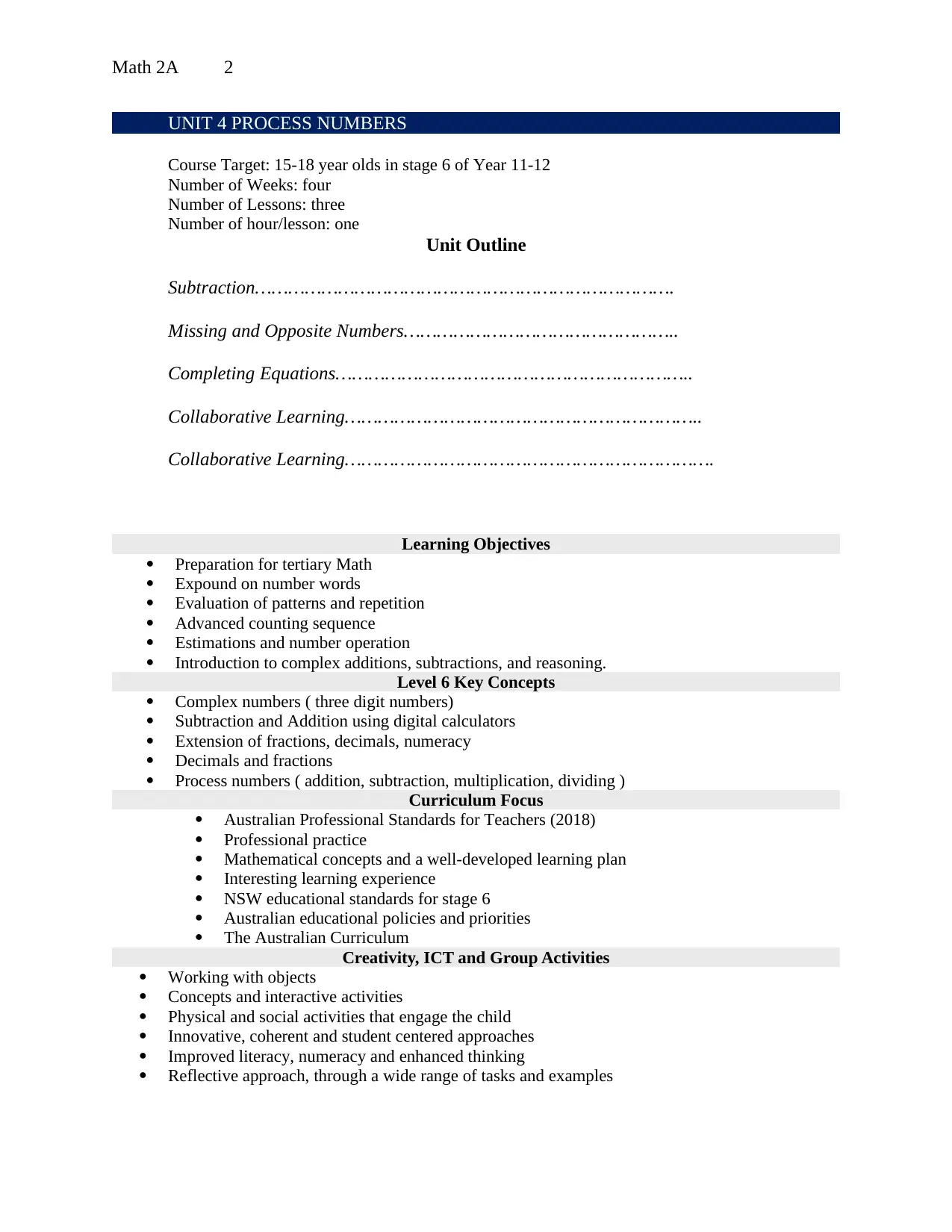
Math 2A 2
UNIT 4 PROCESS NUMBERS
Course Target: 15-18 year olds in stage 6 of Year 11-12
Number of Weeks: four
Number of Lessons: three
Number of hour/lesson: one
Unit Outline
Subtraction………………………………………………………………….
Missing and Opposite Numbers…………………………………………..
Completing Equations………………………………………………………..
Collaborative Learning………………………………………………………..
Collaborative Learning………………………………………………………….
Learning Objectives
Preparation for tertiary Math
Expound on number words
Evaluation of patterns and repetition
Advanced counting sequence
Estimations and number operation
Introduction to complex additions, subtractions, and reasoning.
Level 6 Key Concepts
Complex numbers ( three digit numbers)
Subtraction and Addition using digital calculators
Extension of fractions, decimals, numeracy
Decimals and fractions
Process numbers ( addition, subtraction, multiplication, dividing )
Curriculum Focus
Australian Professional Standards for Teachers (2018)
Professional practice
Mathematical concepts and a well-developed learning plan
Interesting learning experience
NSW educational standards for stage 6
Australian educational policies and priorities
The Australian Curriculum
Creativity, ICT and Group Activities
Working with objects
Concepts and interactive activities
Physical and social activities that engage the child
Innovative, coherent and student centered approaches
Improved literacy, numeracy and enhanced thinking
Reflective approach, through a wide range of tasks and examples
UNIT 4 PROCESS NUMBERS
Course Target: 15-18 year olds in stage 6 of Year 11-12
Number of Weeks: four
Number of Lessons: three
Number of hour/lesson: one
Unit Outline
Subtraction………………………………………………………………….
Missing and Opposite Numbers…………………………………………..
Completing Equations………………………………………………………..
Collaborative Learning………………………………………………………..
Collaborative Learning………………………………………………………….
Learning Objectives
Preparation for tertiary Math
Expound on number words
Evaluation of patterns and repetition
Advanced counting sequence
Estimations and number operation
Introduction to complex additions, subtractions, and reasoning.
Level 6 Key Concepts
Complex numbers ( three digit numbers)
Subtraction and Addition using digital calculators
Extension of fractions, decimals, numeracy
Decimals and fractions
Process numbers ( addition, subtraction, multiplication, dividing )
Curriculum Focus
Australian Professional Standards for Teachers (2018)
Professional practice
Mathematical concepts and a well-developed learning plan
Interesting learning experience
NSW educational standards for stage 6
Australian educational policies and priorities
The Australian Curriculum
Creativity, ICT and Group Activities
Working with objects
Concepts and interactive activities
Physical and social activities that engage the child
Innovative, coherent and student centered approaches
Improved literacy, numeracy and enhanced thinking
Reflective approach, through a wide range of tasks and examples
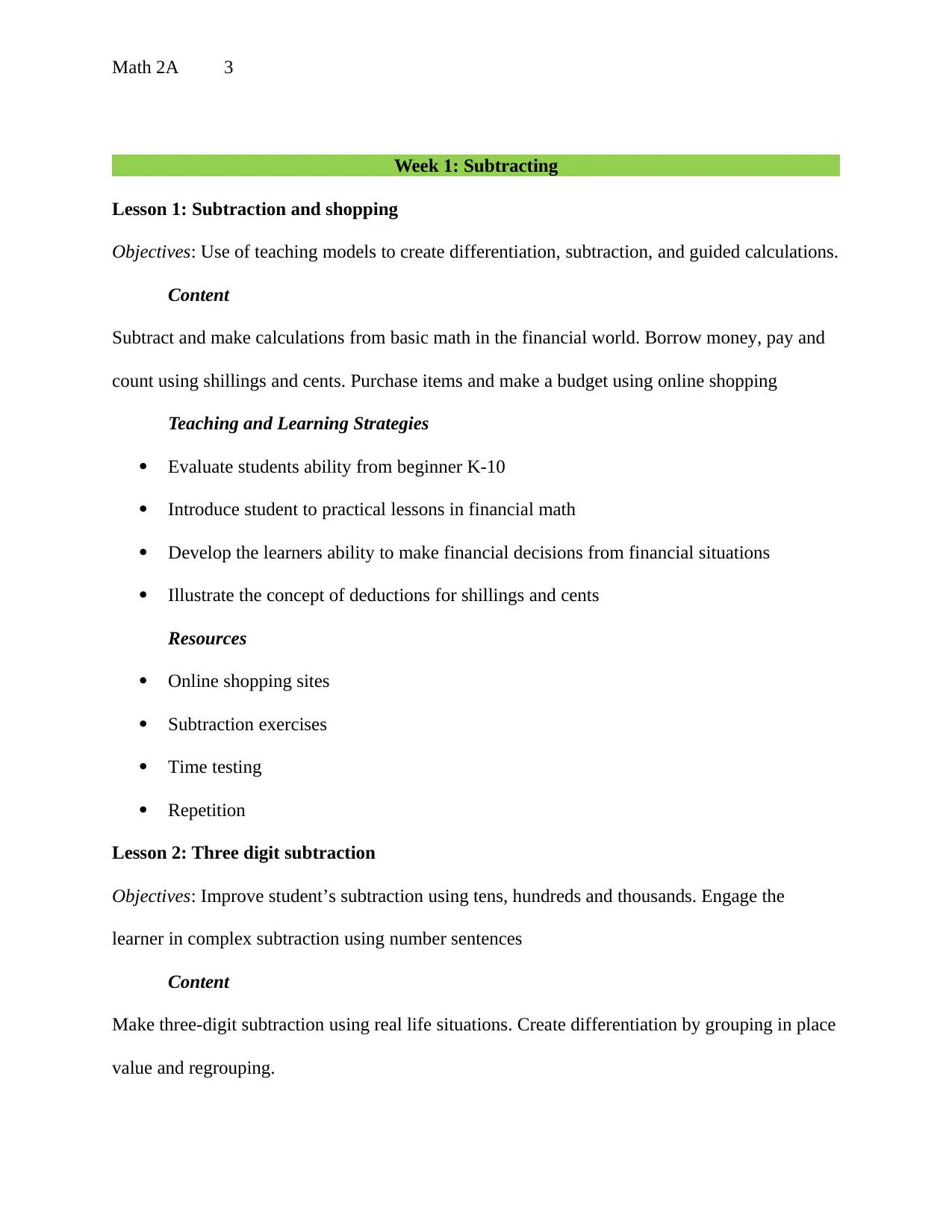
Math 2A 3
Week 1: Subtracting
Lesson 1: Subtraction and shopping
Objectives: Use of teaching models to create differentiation, subtraction, and guided calculations.
Content
Subtract and make calculations from basic math in the financial world. Borrow money, pay and
count using shillings and cents. Purchase items and make a budget using online shopping
Teaching and Learning Strategies
Evaluate students ability from beginner K-10
Introduce student to practical lessons in financial math
Develop the learners ability to make financial decisions from financial situations
Illustrate the concept of deductions for shillings and cents
Resources
Online shopping sites
Subtraction exercises
Time testing
Repetition
Lesson 2: Three digit subtraction
Objectives: Improve student’s subtraction using tens, hundreds and thousands. Engage the
learner in complex subtraction using number sentences
Content
Make three-digit subtraction using real life situations. Create differentiation by grouping in place
value and regrouping.
Week 1: Subtracting
Lesson 1: Subtraction and shopping
Objectives: Use of teaching models to create differentiation, subtraction, and guided calculations.
Content
Subtract and make calculations from basic math in the financial world. Borrow money, pay and
count using shillings and cents. Purchase items and make a budget using online shopping
Teaching and Learning Strategies
Evaluate students ability from beginner K-10
Introduce student to practical lessons in financial math
Develop the learners ability to make financial decisions from financial situations
Illustrate the concept of deductions for shillings and cents
Resources
Online shopping sites
Subtraction exercises
Time testing
Repetition
Lesson 2: Three digit subtraction
Objectives: Improve student’s subtraction using tens, hundreds and thousands. Engage the
learner in complex subtraction using number sentences
Content
Make three-digit subtraction using real life situations. Create differentiation by grouping in place
value and regrouping.
⊘ This is a preview!⊘
Do you want full access?
Subscribe today to unlock all pages.

Trusted by 1+ million students worldwide
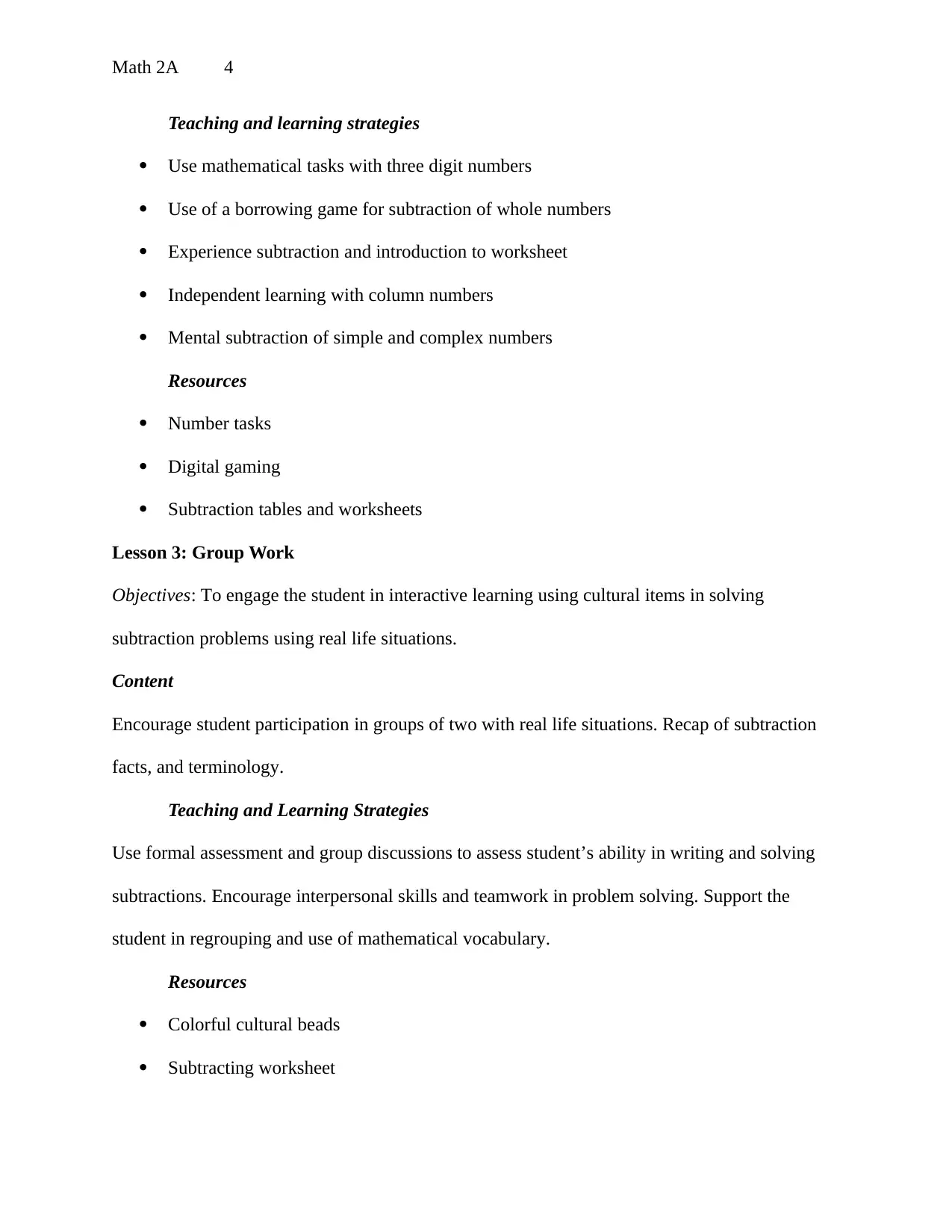
Math 2A 4
Teaching and learning strategies
Use mathematical tasks with three digit numbers
Use of a borrowing game for subtraction of whole numbers
Experience subtraction and introduction to worksheet
Independent learning with column numbers
Mental subtraction of simple and complex numbers
Resources
Number tasks
Digital gaming
Subtraction tables and worksheets
Lesson 3: Group Work
Objectives: To engage the student in interactive learning using cultural items in solving
subtraction problems using real life situations.
Content
Encourage student participation in groups of two with real life situations. Recap of subtraction
facts, and terminology.
Teaching and Learning Strategies
Use formal assessment and group discussions to assess student’s ability in writing and solving
subtractions. Encourage interpersonal skills and teamwork in problem solving. Support the
student in regrouping and use of mathematical vocabulary.
Resources
Colorful cultural beads
Subtracting worksheet
Teaching and learning strategies
Use mathematical tasks with three digit numbers
Use of a borrowing game for subtraction of whole numbers
Experience subtraction and introduction to worksheet
Independent learning with column numbers
Mental subtraction of simple and complex numbers
Resources
Number tasks
Digital gaming
Subtraction tables and worksheets
Lesson 3: Group Work
Objectives: To engage the student in interactive learning using cultural items in solving
subtraction problems using real life situations.
Content
Encourage student participation in groups of two with real life situations. Recap of subtraction
facts, and terminology.
Teaching and Learning Strategies
Use formal assessment and group discussions to assess student’s ability in writing and solving
subtractions. Encourage interpersonal skills and teamwork in problem solving. Support the
student in regrouping and use of mathematical vocabulary.
Resources
Colorful cultural beads
Subtracting worksheet
Paraphrase This Document
Need a fresh take? Get an instant paraphrase of this document with our AI Paraphraser
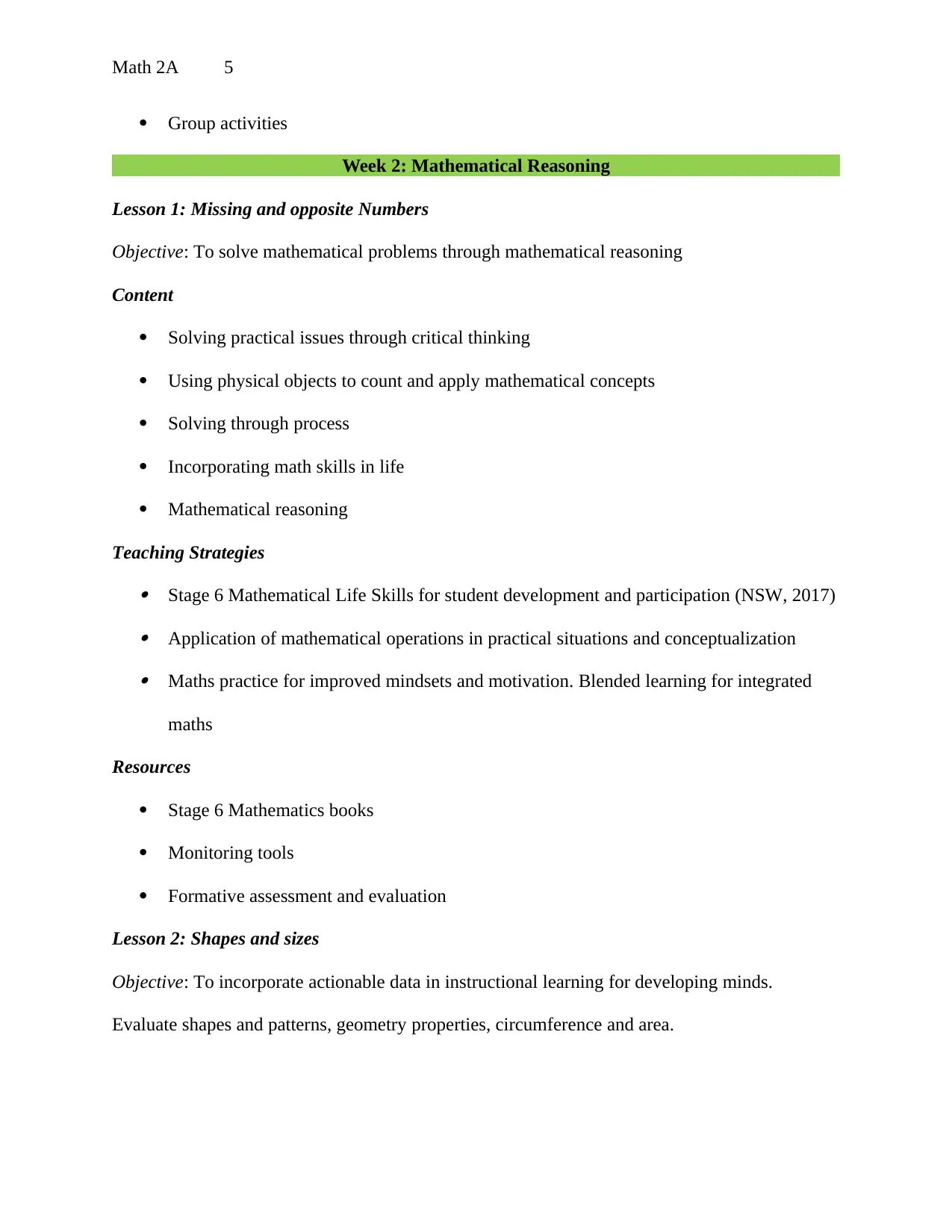
Math 2A 5
Group activities
Week 2: Mathematical Reasoning
Lesson 1: Missing and opposite Numbers
Objective: To solve mathematical problems through mathematical reasoning
Content
Solving practical issues through critical thinking
Using physical objects to count and apply mathematical concepts
Solving through process
Incorporating math skills in life
Mathematical reasoning
Teaching Strategies Stage 6 Mathematical Life Skills for student development and participation (NSW, 2017) Application of mathematical operations in practical situations and conceptualization Maths practice for improved mindsets and motivation. Blended learning for integrated
maths
Resources
Stage 6 Mathematics books
Monitoring tools
Formative assessment and evaluation
Lesson 2: Shapes and sizes
Objective: To incorporate actionable data in instructional learning for developing minds.
Evaluate shapes and patterns, geometry properties, circumference and area.
Group activities
Week 2: Mathematical Reasoning
Lesson 1: Missing and opposite Numbers
Objective: To solve mathematical problems through mathematical reasoning
Content
Solving practical issues through critical thinking
Using physical objects to count and apply mathematical concepts
Solving through process
Incorporating math skills in life
Mathematical reasoning
Teaching Strategies Stage 6 Mathematical Life Skills for student development and participation (NSW, 2017) Application of mathematical operations in practical situations and conceptualization Maths practice for improved mindsets and motivation. Blended learning for integrated
maths
Resources
Stage 6 Mathematics books
Monitoring tools
Formative assessment and evaluation
Lesson 2: Shapes and sizes
Objective: To incorporate actionable data in instructional learning for developing minds.
Evaluate shapes and patterns, geometry properties, circumference and area.
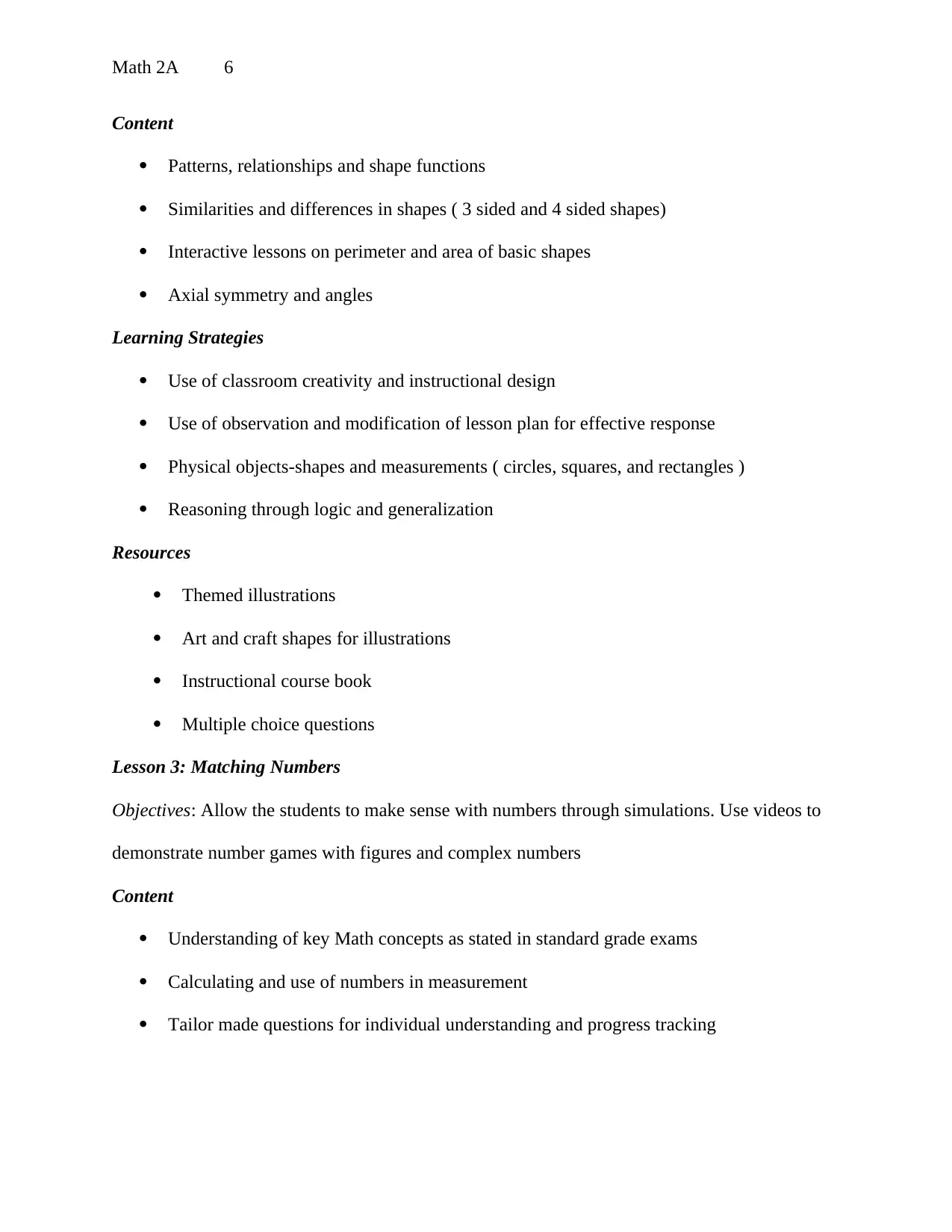
Math 2A 6
Content
Patterns, relationships and shape functions
Similarities and differences in shapes ( 3 sided and 4 sided shapes)
Interactive lessons on perimeter and area of basic shapes
Axial symmetry and angles
Learning Strategies
Use of classroom creativity and instructional design
Use of observation and modification of lesson plan for effective response
Physical objects-shapes and measurements ( circles, squares, and rectangles )
Reasoning through logic and generalization
Resources
Themed illustrations
Art and craft shapes for illustrations
Instructional course book
Multiple choice questions
Lesson 3: Matching Numbers
Objectives: Allow the students to make sense with numbers through simulations. Use videos to
demonstrate number games with figures and complex numbers
Content
Understanding of key Math concepts as stated in standard grade exams
Calculating and use of numbers in measurement
Tailor made questions for individual understanding and progress tracking
Content
Patterns, relationships and shape functions
Similarities and differences in shapes ( 3 sided and 4 sided shapes)
Interactive lessons on perimeter and area of basic shapes
Axial symmetry and angles
Learning Strategies
Use of classroom creativity and instructional design
Use of observation and modification of lesson plan for effective response
Physical objects-shapes and measurements ( circles, squares, and rectangles )
Reasoning through logic and generalization
Resources
Themed illustrations
Art and craft shapes for illustrations
Instructional course book
Multiple choice questions
Lesson 3: Matching Numbers
Objectives: Allow the students to make sense with numbers through simulations. Use videos to
demonstrate number games with figures and complex numbers
Content
Understanding of key Math concepts as stated in standard grade exams
Calculating and use of numbers in measurement
Tailor made questions for individual understanding and progress tracking
⊘ This is a preview!⊘
Do you want full access?
Subscribe today to unlock all pages.

Trusted by 1+ million students worldwide
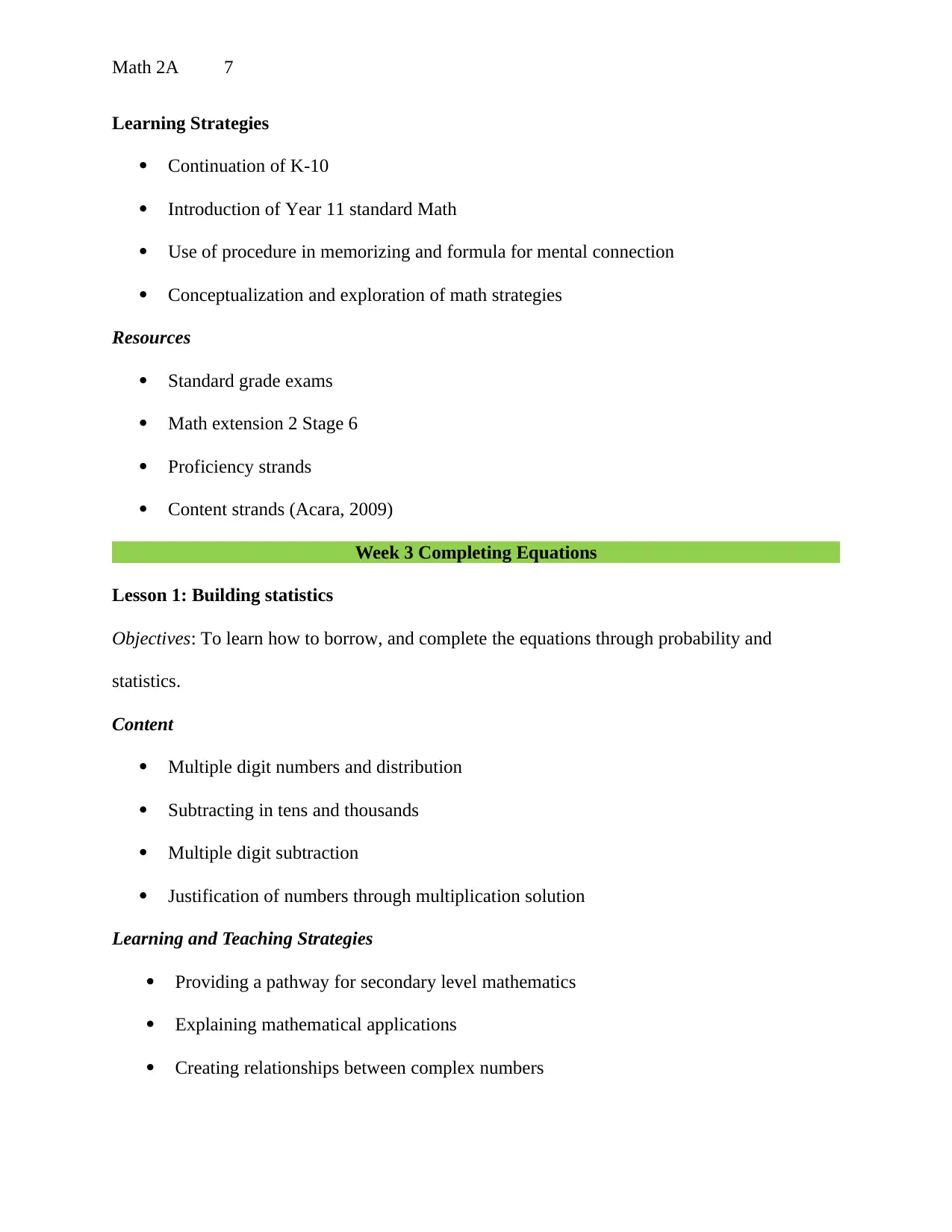
Math 2A 7
Learning Strategies
Continuation of K-10
Introduction of Year 11 standard Math
Use of procedure in memorizing and formula for mental connection
Conceptualization and exploration of math strategies
Resources
Standard grade exams
Math extension 2 Stage 6
Proficiency strands
Content strands (Acara, 2009)
Week 3 Completing Equations
Lesson 1: Building statistics
Objectives: To learn how to borrow, and complete the equations through probability and
statistics.
Content
Multiple digit numbers and distribution
Subtracting in tens and thousands
Multiple digit subtraction
Justification of numbers through multiplication solution
Learning and Teaching Strategies
Providing a pathway for secondary level mathematics
Explaining mathematical applications
Creating relationships between complex numbers
Learning Strategies
Continuation of K-10
Introduction of Year 11 standard Math
Use of procedure in memorizing and formula for mental connection
Conceptualization and exploration of math strategies
Resources
Standard grade exams
Math extension 2 Stage 6
Proficiency strands
Content strands (Acara, 2009)
Week 3 Completing Equations
Lesson 1: Building statistics
Objectives: To learn how to borrow, and complete the equations through probability and
statistics.
Content
Multiple digit numbers and distribution
Subtracting in tens and thousands
Multiple digit subtraction
Justification of numbers through multiplication solution
Learning and Teaching Strategies
Providing a pathway for secondary level mathematics
Explaining mathematical applications
Creating relationships between complex numbers
Paraphrase This Document
Need a fresh take? Get an instant paraphrase of this document with our AI Paraphraser
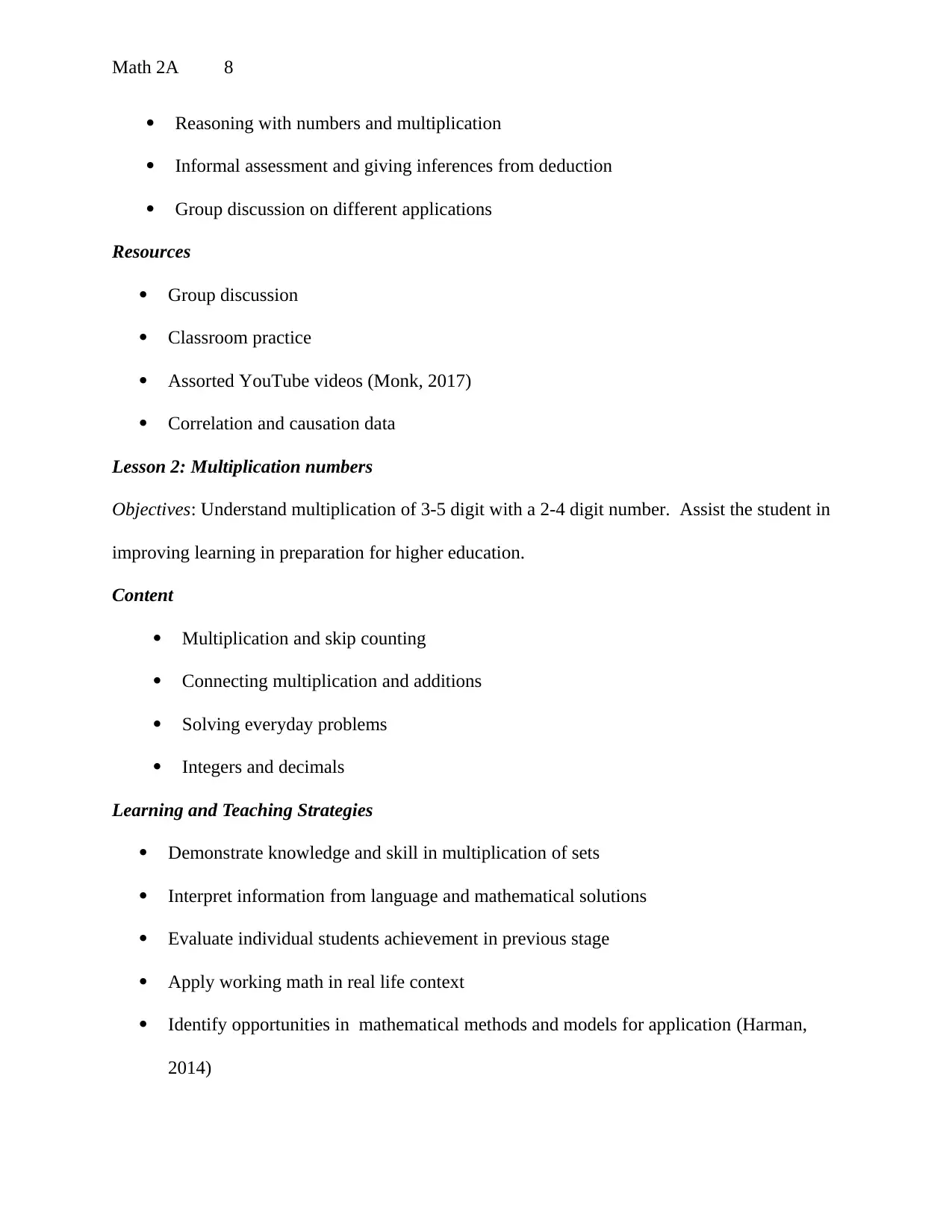
Math 2A 8
Reasoning with numbers and multiplication
Informal assessment and giving inferences from deduction
Group discussion on different applications
Resources
Group discussion
Classroom practice
Assorted YouTube videos (Monk, 2017)
Correlation and causation data
Lesson 2: Multiplication numbers
Objectives: Understand multiplication of 3-5 digit with a 2-4 digit number. Assist the student in
improving learning in preparation for higher education.
Content
Multiplication and skip counting
Connecting multiplication and additions
Solving everyday problems
Integers and decimals
Learning and Teaching Strategies
Demonstrate knowledge and skill in multiplication of sets
Interpret information from language and mathematical solutions
Evaluate individual students achievement in previous stage
Apply working math in real life context
Identify opportunities in mathematical methods and models for application (Harman,
2014)
Reasoning with numbers and multiplication
Informal assessment and giving inferences from deduction
Group discussion on different applications
Resources
Group discussion
Classroom practice
Assorted YouTube videos (Monk, 2017)
Correlation and causation data
Lesson 2: Multiplication numbers
Objectives: Understand multiplication of 3-5 digit with a 2-4 digit number. Assist the student in
improving learning in preparation for higher education.
Content
Multiplication and skip counting
Connecting multiplication and additions
Solving everyday problems
Integers and decimals
Learning and Teaching Strategies
Demonstrate knowledge and skill in multiplication of sets
Interpret information from language and mathematical solutions
Evaluate individual students achievement in previous stage
Apply working math in real life context
Identify opportunities in mathematical methods and models for application (Harman,
2014)
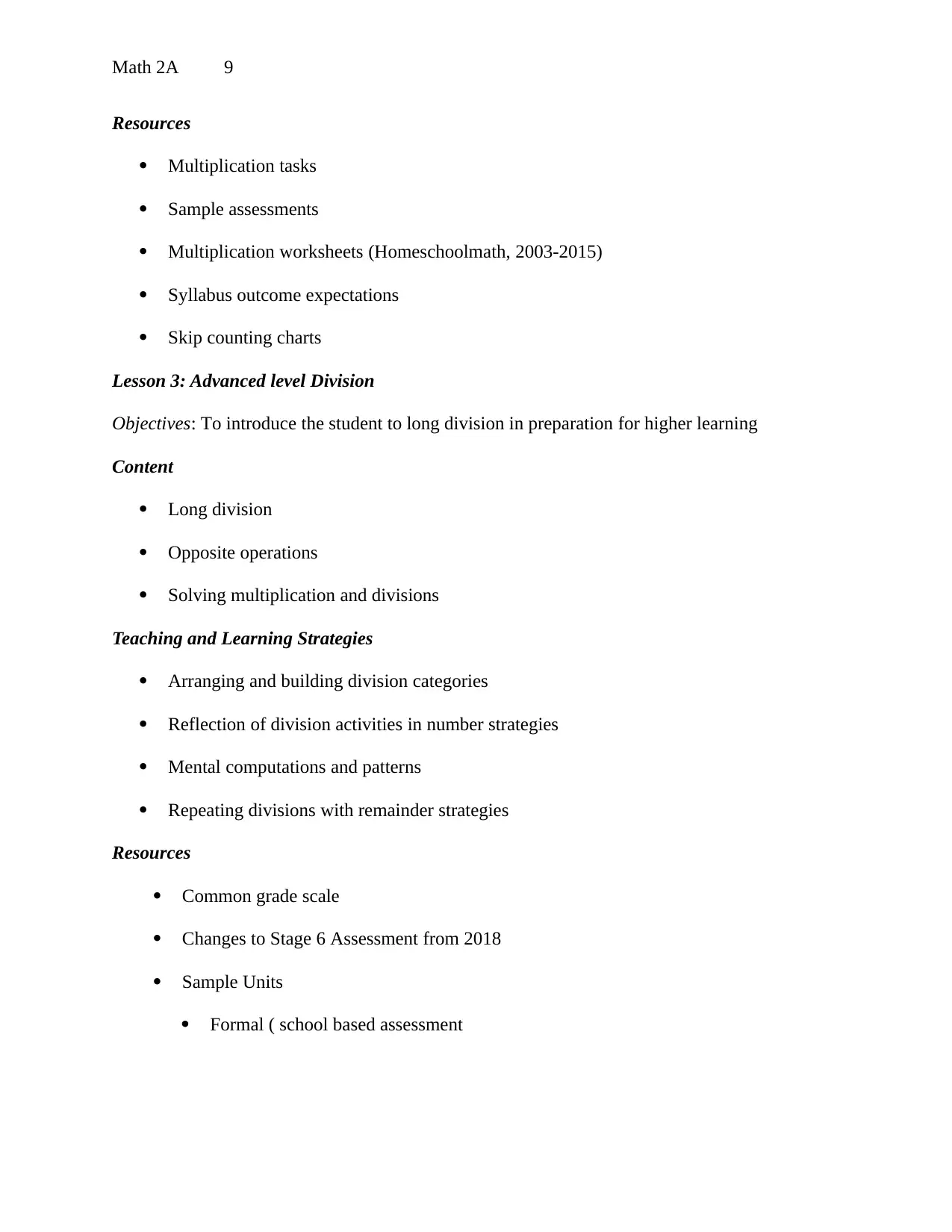
Math 2A 9
Resources
Multiplication tasks
Sample assessments
Multiplication worksheets (Homeschoolmath, 2003-2015)
Syllabus outcome expectations
Skip counting charts
Lesson 3: Advanced level Division
Objectives: To introduce the student to long division in preparation for higher learning
Content
Long division
Opposite operations
Solving multiplication and divisions
Teaching and Learning Strategies
Arranging and building division categories
Reflection of division activities in number strategies
Mental computations and patterns
Repeating divisions with remainder strategies
Resources
Common grade scale
Changes to Stage 6 Assessment from 2018
Sample Units
Formal ( school based assessment
Resources
Multiplication tasks
Sample assessments
Multiplication worksheets (Homeschoolmath, 2003-2015)
Syllabus outcome expectations
Skip counting charts
Lesson 3: Advanced level Division
Objectives: To introduce the student to long division in preparation for higher learning
Content
Long division
Opposite operations
Solving multiplication and divisions
Teaching and Learning Strategies
Arranging and building division categories
Reflection of division activities in number strategies
Mental computations and patterns
Repeating divisions with remainder strategies
Resources
Common grade scale
Changes to Stage 6 Assessment from 2018
Sample Units
Formal ( school based assessment
⊘ This is a preview!⊘
Do you want full access?
Subscribe today to unlock all pages.

Trusted by 1+ million students worldwide
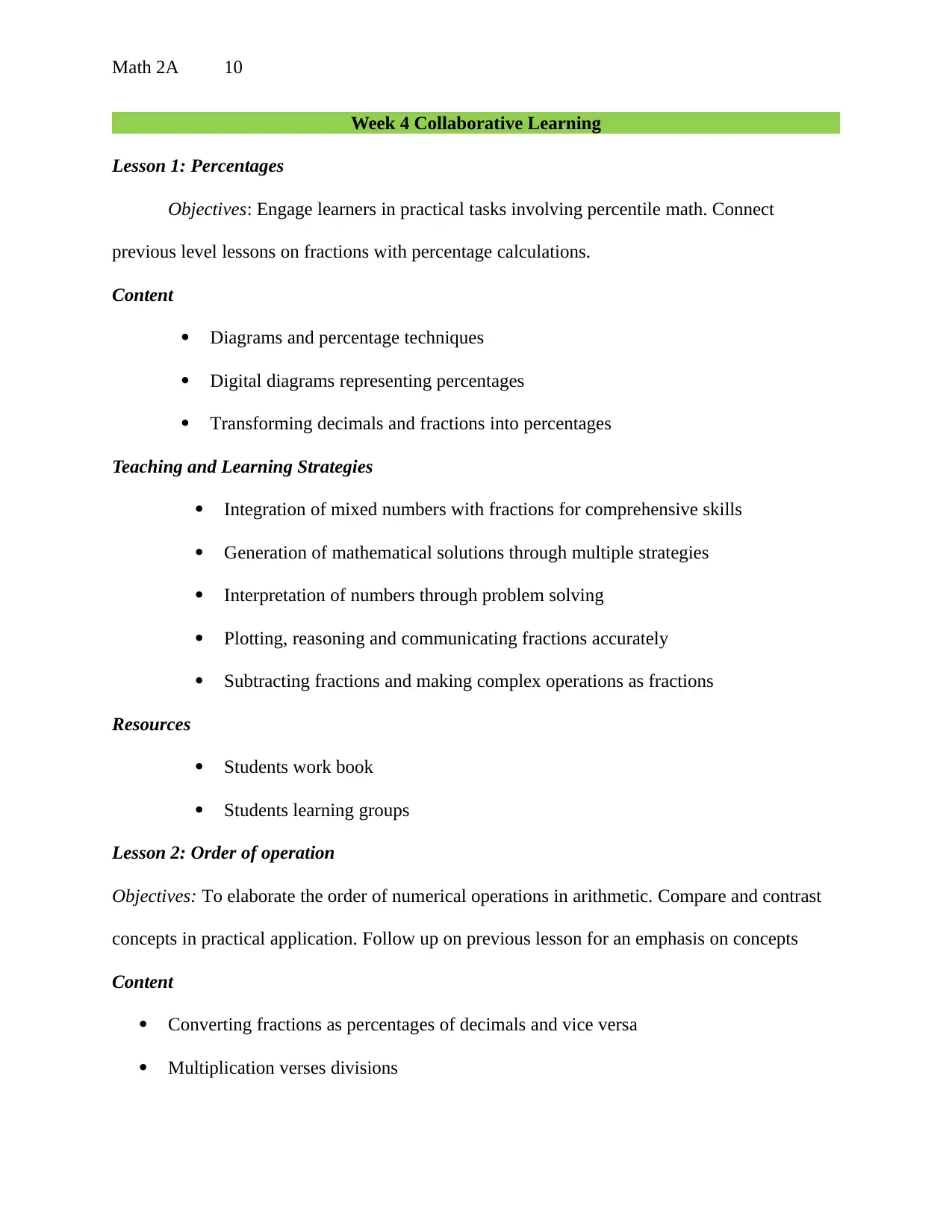
Math 2A 10
Week 4 Collaborative Learning
Lesson 1: Percentages
Objectives: Engage learners in practical tasks involving percentile math. Connect
previous level lessons on fractions with percentage calculations.
Content
Diagrams and percentage techniques
Digital diagrams representing percentages
Transforming decimals and fractions into percentages
Teaching and Learning Strategies
Integration of mixed numbers with fractions for comprehensive skills
Generation of mathematical solutions through multiple strategies
Interpretation of numbers through problem solving
Plotting, reasoning and communicating fractions accurately
Subtracting fractions and making complex operations as fractions
Resources
Students work book
Students learning groups
Lesson 2: Order of operation
Objectives: To elaborate the order of numerical operations in arithmetic. Compare and contrast
concepts in practical application. Follow up on previous lesson for an emphasis on concepts
Content
Converting fractions as percentages of decimals and vice versa
Multiplication verses divisions
Week 4 Collaborative Learning
Lesson 1: Percentages
Objectives: Engage learners in practical tasks involving percentile math. Connect
previous level lessons on fractions with percentage calculations.
Content
Diagrams and percentage techniques
Digital diagrams representing percentages
Transforming decimals and fractions into percentages
Teaching and Learning Strategies
Integration of mixed numbers with fractions for comprehensive skills
Generation of mathematical solutions through multiple strategies
Interpretation of numbers through problem solving
Plotting, reasoning and communicating fractions accurately
Subtracting fractions and making complex operations as fractions
Resources
Students work book
Students learning groups
Lesson 2: Order of operation
Objectives: To elaborate the order of numerical operations in arithmetic. Compare and contrast
concepts in practical application. Follow up on previous lesson for an emphasis on concepts
Content
Converting fractions as percentages of decimals and vice versa
Multiplication verses divisions
Paraphrase This Document
Need a fresh take? Get an instant paraphrase of this document with our AI Paraphraser
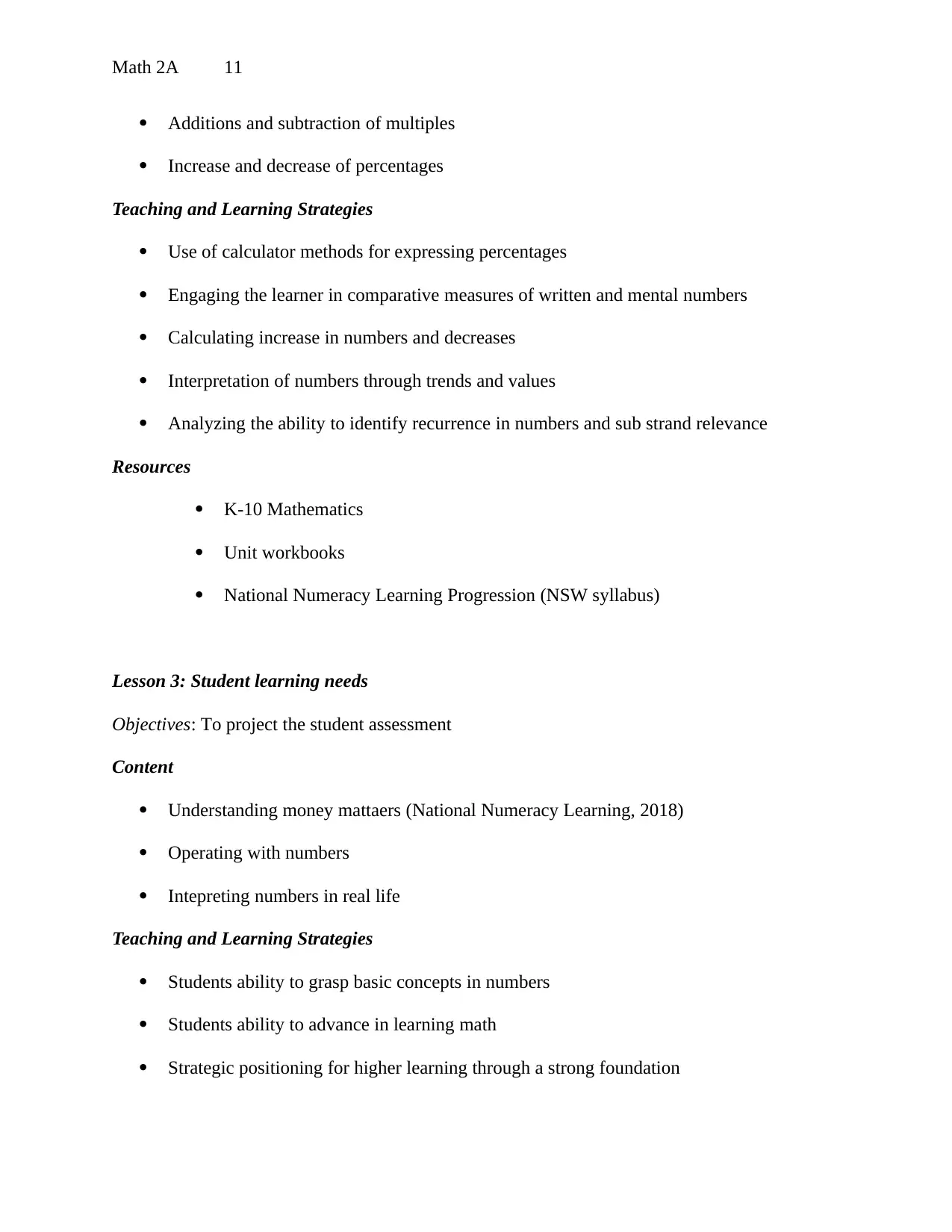
Math 2A 11
Additions and subtraction of multiples
Increase and decrease of percentages
Teaching and Learning Strategies
Use of calculator methods for expressing percentages
Engaging the learner in comparative measures of written and mental numbers
Calculating increase in numbers and decreases
Interpretation of numbers through trends and values
Analyzing the ability to identify recurrence in numbers and sub strand relevance
Resources
K-10 Mathematics
Unit workbooks
National Numeracy Learning Progression (NSW syllabus)
Lesson 3: Student learning needs
Objectives: To project the student assessment
Content
Understanding money mattaers (National Numeracy Learning, 2018)
Operating with numbers
Intepreting numbers in real life
Teaching and Learning Strategies
Students ability to grasp basic concepts in numbers
Students ability to advance in learning math
Strategic positioning for higher learning through a strong foundation
Additions and subtraction of multiples
Increase and decrease of percentages
Teaching and Learning Strategies
Use of calculator methods for expressing percentages
Engaging the learner in comparative measures of written and mental numbers
Calculating increase in numbers and decreases
Interpretation of numbers through trends and values
Analyzing the ability to identify recurrence in numbers and sub strand relevance
Resources
K-10 Mathematics
Unit workbooks
National Numeracy Learning Progression (NSW syllabus)
Lesson 3: Student learning needs
Objectives: To project the student assessment
Content
Understanding money mattaers (National Numeracy Learning, 2018)
Operating with numbers
Intepreting numbers in real life
Teaching and Learning Strategies
Students ability to grasp basic concepts in numbers
Students ability to advance in learning math
Strategic positioning for higher learning through a strong foundation
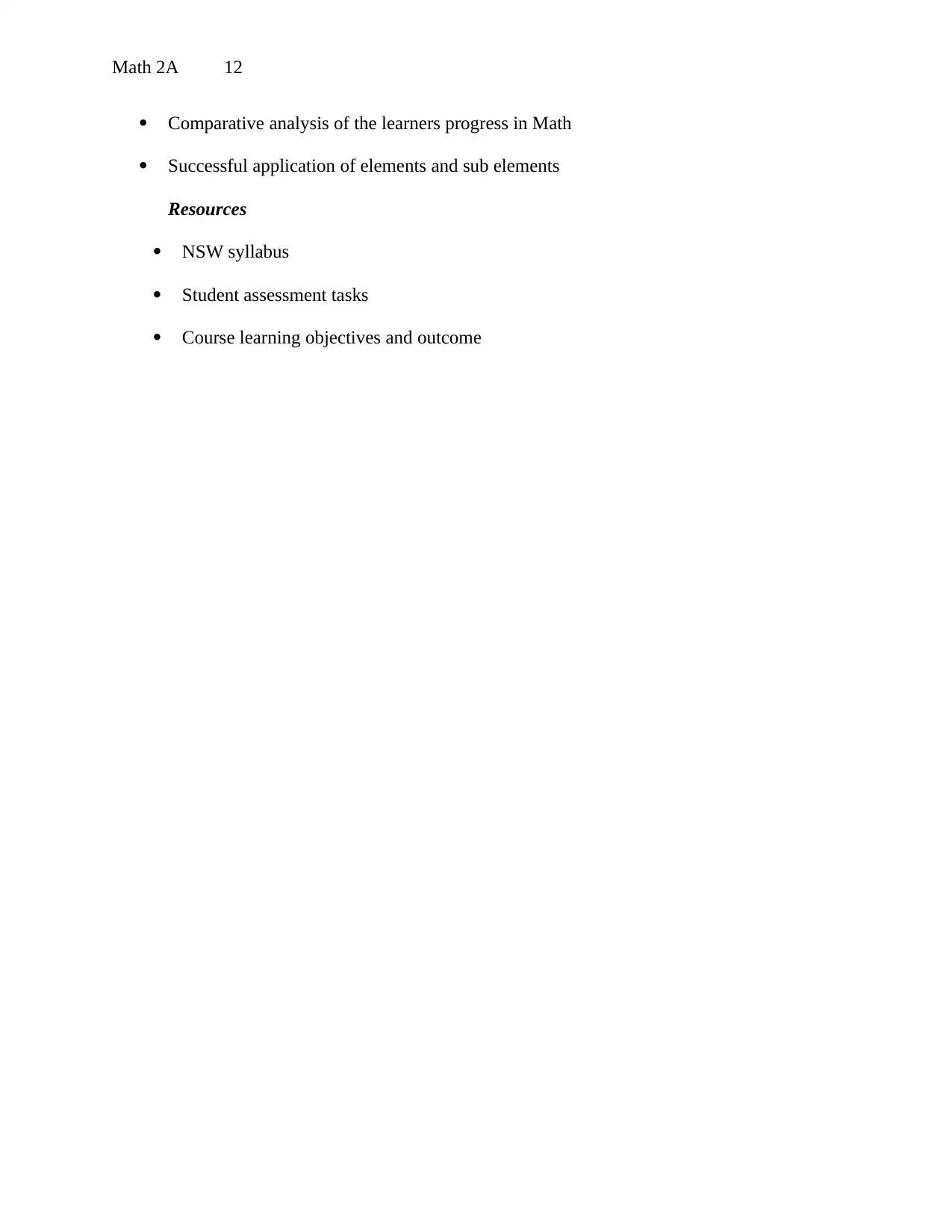
Math 2A 12
Comparative analysis of the learners progress in Math
Successful application of elements and sub elements
Resources
NSW syllabus
Student assessment tasks
Course learning objectives and outcome
Comparative analysis of the learners progress in Math
Successful application of elements and sub elements
Resources
NSW syllabus
Student assessment tasks
Course learning objectives and outcome
⊘ This is a preview!⊘
Do you want full access?
Subscribe today to unlock all pages.

Trusted by 1+ million students worldwide
1 out of 22
Related Documents
Your All-in-One AI-Powered Toolkit for Academic Success.
+13062052269
info@desklib.com
Available 24*7 on WhatsApp / Email
![[object Object]](/_next/static/media/star-bottom.7253800d.svg)
Unlock your academic potential
Copyright © 2020–2025 A2Z Services. All Rights Reserved. Developed and managed by ZUCOL.





